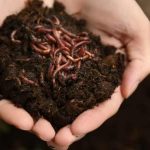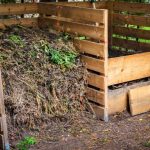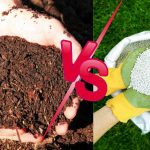Springtails, the tiny soil-dwelling arthropods, are like nature’s cleanup crew, working their magic beneath the surface of the soil. They’re actually good for the environment.
Springtails munch on decaying organic matter like leaves and mold, making them valuable contributors to the nutrient cycle. This not only boosts soil health but also improves its structure.
What’s even better is that they are completely harmless to gardens and won’t nibble on you or your plants. Their presence in your garden is a sign of healthy soil.
They feed on fungi, microbes, and decomposing materials, effectively recycling environmental debris.
Again, they might even help clean up allergens. So, if you have potted plants, consider giving them a home in the soil, and don’t forget to toss in some dead leaves for them to enjoy.
However, in large quantities, they can damage plant roots and seedlings, causing harm to plant growth. It is essential to maintain a balanced springtail population for a healthy ecosystem.
What Are Springtails?
Springtails are minute hexapods that belong to the class Collembola. They are incredibly small, usually measuring between 0. 25 to 6 millimeters in length.
These tiny creatures get their name from a unique structure called the furcula, located on their abdomen.
When threatened or disturbed, they use this furcula to launch themselves into the air, hence the name “springtails. “
Here is its class:
- Scientific name: Collembola
- Kingdom: Animalia
- Phylum: Arthropoda
- Subphylum: Hexapoda

Identification and characteristics:
Springtails come in various colors, including white, gray, black, and even purple. This vast color diversity makes them easily recognizable.
They have soft bodies, elongated shapes, and segmented bodies, consisting of a head, thorax, and abdomen.
Despite their six legs, springtails do not have wings. Instead, they rely on their furcula for movement.
Springtails also possess a unique feature known as the collophore, which resembles a tail-like appendage.
How Springtails Impact Soil Ecosystems?
Springtails are the second most abundant group of soil-dwelling organisms in the world. Their population densities can range from 300 million to 1.4 billion per acre depending on factors such as climate, soil type, and the presence of food and predators.
They’re like nature’s cleanup crew, gobbling up old leaves, fungi, and more. This helps turn the stuff in the soil into smaller pieces, which is great for plants.
But that’s not all – they also recycle nutrients by pooping them back into the soil. Springtails are like little earthworms, too. They dig tunnels in the soil, making it easier for water and plant roots to move around.
Also, they’re bug-eating champions, keeping the bad bugs in check. These little guys are everywhere in healthy soil, showing how important they are.

Credit: www.house-plant-hobbyist.com
Benefits Of Springtails In Soil
Springtails in the soil can be incredibly helpful. They’re like nature’s little workers, aiding in soil aeration, nutrient recycling, and breaking down dead stuff, which is important for gardens and farms.
Springtails are tiny bugs that like to live in damp soil. Even though not many people know about them, they do big things for the soil. Let’s learn about what they do:
Nutrient Recycling and Breaking Things Down:
Springtails are like nature’s recyclers. They eat up things like dead plants, fungi, and bacteria, turning them into simpler forms that plants can use. This helps plants get the food they need to grow.
You May Read: How to Get Rid of Termites in The Garden? ( In-depth Guide )
Improving Soil and Making It Breathe:
Springtails dig tunnels in the soil, which helps air, water, and plant roots move around. This makes the soil healthier because it gets more oxygen and doesn’t get too squished.
Mixing Things Up and Keeping Soil Healthy:
By moving around, springtails mix the different layers of soil, preventing it from getting too hard. This keeps the soil happy and helps plants grow better.
Will Springtails Harmful In Soil?
Springtails like to snack on the roots of baby plants, and that’s not good. When they do that, it hurts the plants and makes them more likely to get sick and bothered by other bugs.
This can cause the plants to stay small and not grow up healthy.
Some crops, like lettuce, carrots, and beans, are like springtail magnets.
When springtails invade, they eat up the seeds, sprouts, and little plants, which makes it hard for them to grow.
It’s like they’re playing hide and seek with the plants’ food, and the plants lose. Plus, springtails can block the plants from getting the nutrients they need, making them even more unhappy.
What are the methods for controlling and preventing springtail populations in soil, and how can you do it organically?
Springtails can be both helpful and troublesome in soil. If you want to control their numbers in an eco-friendly way, there are various organic methods to consider:
Neem Oil and Other Botanical Insecticides:
Neem oil is a natural insect repellent derived from the neem tree. It disrupts springtails’ growth and feeding patterns.
Dilute neem oil as per the label instructions and spray it on affected areas. Repeat every few days until the population decreases.
Other botanical insecticides like pyrethrins, derived from chrysanthemum flowers, can also help.

Beneficial Nematodes and Predatory Mites:
Beneficial nematodes are microscopic worms that prey on springtails, and they can be applied to the soil. Mix them with water and apply as directed.
Predatory mites are another option, consult with a local expert to find the right mites for your situation.
Soil Amendments and Beneficial Microorganisms:
Diatomaceous earth, a fine powder made from diatoms, creates a physical barrier and dehydrates springtails. Sprinkle it in damp areas.
Beneficial microorganisms like Bacillus thuringiensis var. Israelensis (Bti) can be used to target and kill springtails without harming beneficial insects.
Adding organic matter to the soil helps improve drainage and creates less favorable conditions for springtails.
Frequently Asked Questions
Are Springtails Good For Potted Plants?
Springtails are beneficial to potted plants. They are decomposers that feed on microbes, fungi, and decaying matter in the soil. They are harmless to plants and help to improve the health of the compost. Springtails are commonly found in indoor living soil systems.
They can be brought into the home on contaminated compost and spread to nearby plants by their furcula (spring-like tail).
Should I Put Springtails In My Houseplants?
Yes, you can definitely introduce springtails to your indoor potted plants. Springtails offer many advantages for your plants. They help keep your plant’s environment healthy by munching on dead leaves, preventing root rot and fungal infections, and even enriching the soil through their waste.
Additionally, these tiny critters consume bacteria, fungi, lichens, algae, and decaying matter, which is great for maintaining a clean and balanced ecosystem in your potted plants. They are completely harmless to your green companions.
You might find springtails in your houseplants if you’ve used contaminated compost. Their spring-like appendage, known as a furcula, enables them to hop around.
Springtails can be distinguished from fleas, as they are usually smaller, lighter in color, and lack the ability to bite.

Should I Worry About Springtails?
Springtails are harmless to people, pets, and buildings. They do not bite, sting, or carry diseases, nor do they damage food, clothes, furniture, or property. However, they can be a nuisance because they can enter homes in large numbers.
They are often mistaken for fleas because of their small size and ability to jump. Springtails feed on decaying roots and fungi and rarely damage plants.
If you see them in houseplants, you may be overwatering them. Allowing the plants to dry out should solve the problem.
Conclusion
Springtails in soil can provide both benefits and drawbacks to gardeners and homeowners. On the positive side, these tiny creatures help break down organic matter, aerate the soil, and promote nutrient cycling. They also serve as a food source for other beneficial organisms like spiders and beetles.
However, in large numbers, springtails can become a nuisance and cause cosmetic damage to plants. While they are generally harmless, their presence could indicate underlying issues such as excessive moisture or poor drainage.
To find the right balance, it’s important to maintain proper soil conditions, avoid overwatering, and implement integrated pest management strategies if necessary.

I am a graduate of Bangladesh Agricultural University, where I delved into various agricultural disciplines, equipping me with a profound understanding of agriculture. Beyond academics, I have hands-on experience in gardening and crop cultivation. My passion is to embrace sustainable farming and horticulture. With a BSc in Agriculture, I am dedicated to promoting environmentally conscious and efficient agrarian practices.
Bachelor of Science (BSc) in Agriculture (Hons.)
Master of Science. (Sustainable Agriculture & Food Security ) (MS)
Bangladesh Agricultural University




